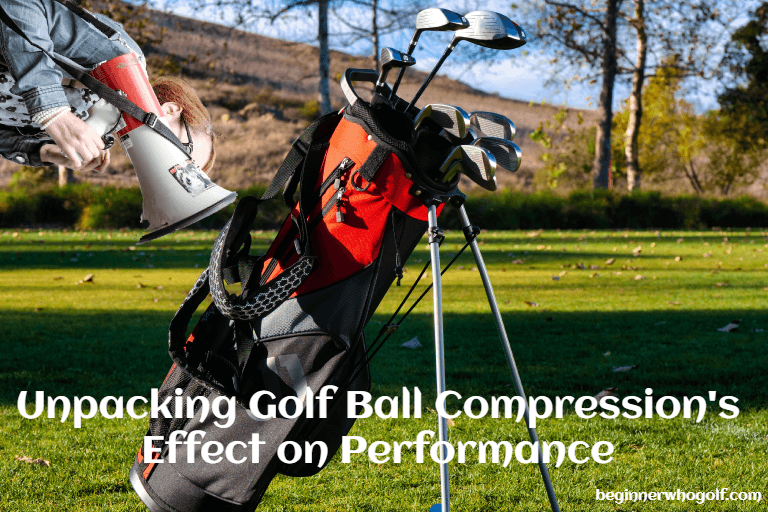Unlock Your Potential: How Far Should a Beginner Hit a Golf Ball?
Many novice golfers often wonder about their game and frequently ask ‘How far should a beginner hit a golf ball?‘. This is because they may feel unsure about their performance and technique. It’s important to remember that as a beginner, it takes time to improve your distance. I think many beginner golfers are tormented by the disappointing feeling of “I thought I could do more…”. Additionally, several factors influence this distance, which we will discuss later on in this article.
Based on my knowledge, as a beginner golfer, you should aim to hit the golf ball between 100-200 yards, which largely depends on the golf club you are using. We understand that many of you may be confused about selecting the right golf equipment. For guidance, you can check out Golf Span’s list of the best golf clubs for 2024.
Novice golfers can enhance their skills and gradually boost their distance by consistently practicing their swing. While some beginners may have the ability to hit shots over 200 yards, this is often influenced by a combination of factors, such as physical strength, equipment, and most importantly, proper swing technique. For those who have yet to achieve this level of distance, there is no need to fret. We can offer guidance to assist you in increasing your distance as much as possible. So, with daily practice and dedication to improving your swing, beginners can see an improvement in their performance on the course.
What is the average distance for a beginner golfer
According to a survey conducted by the National Golf Foundation, the average driving distance for male beginner golfers is about 150 yards, while the average driving distance for female beginner golfers is about 100 yards. However, this distance can vary depending on factors like the golf club being used, the golfer’s strength, and the ball position.
| Golf Club | Average Driving Distance for Male Beginner Golfers | Average Driving Distance for Female Beginner Golfers |
| Driver | 170-200 yards | 100-150 yards |
| Fairway Woods | 120-150 yards | 70-100 yards |
| Irons | 80-120 yards | 50-80 yards |
| Wedges | 30-80 yards | 30-60 yards |
Related: Pro V1 Review By Beginner Who Golf.

Is 200 yards a good drive for a beginner
Based on my opinion, hitting the ball to around 200 yards is ideal for beginner golfers. As a new golfer, being able to hit the ball this far is already a great accomplishment. However, with practice, you can work on driving the ball even farther.
| Distance (yards) | Beginner Golfers | Medium Golfers | Experienced Golfers |
| Driver | 150-200 | 200-230 | 230-270 |
| Fairway Woods | 80-120 | 120-160 | 160-200 |
| Irons | 50-100 | 100-150 | 150-200 |
| Wedges | 30-60 | 60-100 | 100-140 |
| Putter | 10-30 | 10-30 | 10-30 |
What factors influence how far a beginner golfer can hit the ball
As we discussed earlier, several factors determine the distance a beginner golfer can hit the ball, including golf equipment, technique, fitness, and environmental conditions. Golf clubs, including drivers and irons, and golf balls with softer or harder covers can affect the distance of the ball. Proper technique, including grip, stance, backswing, downswing, and follow-through, is essential. Physical fitness, combining strength, flexibility, and endurance, also influences the golfer’s performance. Environmental factors, such as temperature, altitude, humidity, and wind speed and direction, can either help or hinder the ball’s flight.
Golf Equipment
Equipment plays a vital role in the distance a beginner golfer can hit the ball. Golf clubs are designed to optimize ball launch, spin, and speed. For instance, drivers are better suited for long-distance shots than irons. A driver’s longer shaft and larger clubhead help generate more speed and distance. Similarly, the type of golf ball used can also affect the shot’s distance. Soft-covered golf balls tend to spin more, increasing the ball’s distance, but they may be harder for beginners to control. Conversely, harder-covered golf balls spin less, potentially traveling less distance.
Technique
The technique used is another key factor affecting how far a beginner golfer can hit the ball. Golf swing technique comprises grip, stance, backswing, downswing, and follow-through. A correct grip can aid in generating more power and control over the clubface. Proper stance is also crucial, as it affects balance and shot direction. By following a proper backswing and downswing sequence, a beginner golfer can generate more clubhead speed and hit the ball farther. Additionally, a good follow-through can help maintain balance and maximize the shot’s distance.
Fitness
Physical fitness is a significant factor in determining how far a beginner golfer can hit the ball. To perform at their best, golfers like you require a blend of strength, flexibility, and endurance. A physically fit beginner golfer has a higher likelihood of generating more clubhead speed and hitting the ball further. Strength training can help to develop power in their swing, flexibility training can enhance their range of motion, and endurance training can maintain their energy levels for consistent shots throughout a round of golf.
Environmental conditions
The distance a beginner golfer can hit the ball can be influenced by environmental conditions as well. Factors such as temperature, altitude, humidity, and wind speed can all affect the ball’s flight and distance. Cooler temperatures can cause the ball to travel a shorter distance, while warmer temperatures can cause the ball to travel a longer distance. Similarly, a higher altitude can increase the ball’s distance due to less air resistance. Wind speed and direction can also play a role in the ball’s flight, and skilled golfers can use this to their advantage.
What can a beginner golfer do to increase their distance / How To Hit A Golf Ball For Beginners
For novice golfers, enhancing the distance of their shots can be a difficult but worthwhile endeavor. The reason why you can’t do what you can do on the practice field is that you don’t know how to hit and how to attack. Even if you are a beginner, “Don’t go around assuming a nice shot” or “Avoid while conscious of the direction you shouldn’t hit” will steadily appear in your golf score. This time, when you get lost in golf, I will tell you the points to look back on. As a solid foundation of golf, please use it for reviewing how to swing, focusing on grip and address. Hold down the tricks of how to hit and keep improving!
3 Tips to Keep in Mind When You Hit the Golf Course
Check OB and bunker positions first!
During a round of golf, it’s crucial to avoid focusing on where you don’t want the ball to go. As a beginner, it’s easy to get lost in the setup position. Stay mindful and focused on where you want to hit the ball instead.
Hit the ball! Aren’t you trying too hard?
Don’t assume you’ll make a nice shot every time. As a beginner, it’s important to understand your abilities and tendencies and strategize how to overcome them.
Plan ahead and think about your next shot. Getting into this habit can help improve your game.
The atmosphere on the golf course is completely different from the driving range, and it’s easy for beginners to feel lost. It’s important to avoid causing trouble and take the time to focus on proper swing techniques. Even professional golfers can struggle with hitting and attacking the ball, so beginners should start by building a solid foundation and mastering the basics of the game.
Related: Top-Rated Golf Balls For Starters.
“Struggling with hitting” What tips should golf beginners look back on?
Let’s review the most important golf swings for playing the game.
Grip
The grip is one of the most critical components of the golf swing, and even small adjustments can have a significant impact on your shots. Here are some tips to keep in mind:
- When gripping the club, make sure you can see the grip end from your left hand. Check your left hand from above to ensure a proper grip.
- As a beginner, a strong grip with two knuckles visible on the left hand is recommended for an easier swing.
- If you see three or more bumps on your left hand from above, it may cause hooking. Conversely, if you only see one bump, it may lead to slicing.
- Avoid gripping the club too tightly. Hold it with just enough force to feel the weight of the club head.
Address
The address is directly connected to a nice shot, such as hitting the ball at the target. It’s a point that tends to be overlooked in golf, so let’s hold it firmly. If your head moves during your swing or your movements are awkward, check it out.
The correct stance is to stand straight and bend your upper body about 30 degrees from the base of your feet. At that time, make sure that the three lines of the shoulders, hips, and legs are parallel.
Take Back
When taking your swing back, it’s essential to maintain the correct axis and avoid moving your head. This will help you maintain the forward-leaning posture established during the address. Remember to stay aware of your head position throughout the swing.

V-Zone
To ensure proper swing technique, aim to swing within the “V-zone” formed by the line connecting your right shoulder and the golf ball, and the line connecting the shaft and the golf ball. Swinging below the V-zone may cause a hook, while swinging above the V-zone may cause a slice.
Top
Novice golfers can minimize their missed shots by avoiding lifting the club too high. When taking your swing back, pay attention to the position of your left wrist. If it breaks on the palm side at the top, it may cause a slice, while breaking on the instep side may lead to a hook.
Downswing
Utilize a hip twist during your swing to improve the trajectory of your shot. The way you move your body and the path of your swing are crucial factors in golf. The downswing, in particular, is considered the most challenging part of the game because it largely determines the direction and quality of the shot. In fact, an outside trajectory is a common issue for novice golfers and can significantly impact the outcome of the shot.
Impact
The key is to swing as if you’re hitting a golf ball just 10cm away from the clubface. Instead of trying to hit the ball hard, focus on a smooth and controlled swing. Additionally, be mindful not to open or close the clubface too much.
Follow Through

How To Hit A Golf Ball For Beginners?
If you focus too much on the golf ball, you’ll only hit it, and your follow-through will be perfunctory.
- Swing through the ball with the image of running the club head.
- Don’t shift too much weight onto the right foot. Ensure proper weight transfer.
Finish
All the weight should be on the left leg, with no weight left on the right foot. It’s perfect if you can tap the ground with your toes.
Check By Trouble! Hold Here
In golf, if you are concerned about whiffs, duffs, and tops, let’s review primarily the grip, address, center of gravity, and whether you are striking the ball with your hands. Let’s also review the trajectory of slices and hooks with grip, address, face, and club downswing.
(1) “Missed swings” that are troublesome for beginner golfers
Golf is a sport where you hit a ball with a diameter of about 4.3 cm at your feet. Unlike baseball or tennis, the ball is stationary, so why does it fly through the air? This can be a challenge for novice golfers. You have to tackle this.
(2) Don’t fly straight!!
The biggest problem for beginner golfers is not hitting the ball straight. No matter how many times you hit it, if all your shots end up in the rough or out of bounds, you’ll get really frustrated and golf won’t be enjoyable. Hitting a golf ball straight is necessary to improve your distance in golf.
Is Distance The Single Most Important Thing In Golf
It is vital to understand that while distance plays a significant role in golf, it is not the only aspect that determines a golfer’s performance. Accuracy, consistency, and sound course management are also essential factors that contribute to a golfer’s success. As a beginner, it is critical for you to prioritize enhancing your overall game instead of solely focusing on distance. By investing time and effort into all aspects of the game, you can become a well-rounded golfer and increase your chances of achieving success on the course.
Beginner golfers can take their game to the next level by seeking the guidance of a golf instructor or coach. Working with a golf professional can assist them in refining their technique, receiving feedback on their swing, and selecting appropriate equipment. Additionally, instructors can offer recommendations on physical fitness and aid beginners in creating a workout plan that will increase their strength, flexibility, and endurance, leading to improved performance on the course.
Along with seeking professional guidance, beginner golfers like you can enhance their skills by practicing regularly. Consistent practice aids in developing muscle memory, refining the swing, and building confidence on the course. You should aim to practice a variety of shots, such as drives, irons, and short-game shots, to establish a well-rounded game. By dedicating time and effort to practice, you can steadily improve your game and reach your golfing goals.
Closing
To summarize, maximizing your potential in golf involves a range of elements, such as having a proper swing technique, maintaining physical fitness, selecting the right equipment, and making wise decisions on the course. As a beginner, focusing on building a solid foundation and progressively improving your skills is crucial. While there is no set distance that a beginner should hit a golf ball, dedicating sufficient time and effort to practice and implementing the tips outlined above can aid in increasing your distance and overall performance on the course. With determination and persistence, you can unleash your potential and achieve your objectives in golf. Let’s start wearing a beautiful form from a beginner’s age and improve our score. Golf will become more and more fun.






